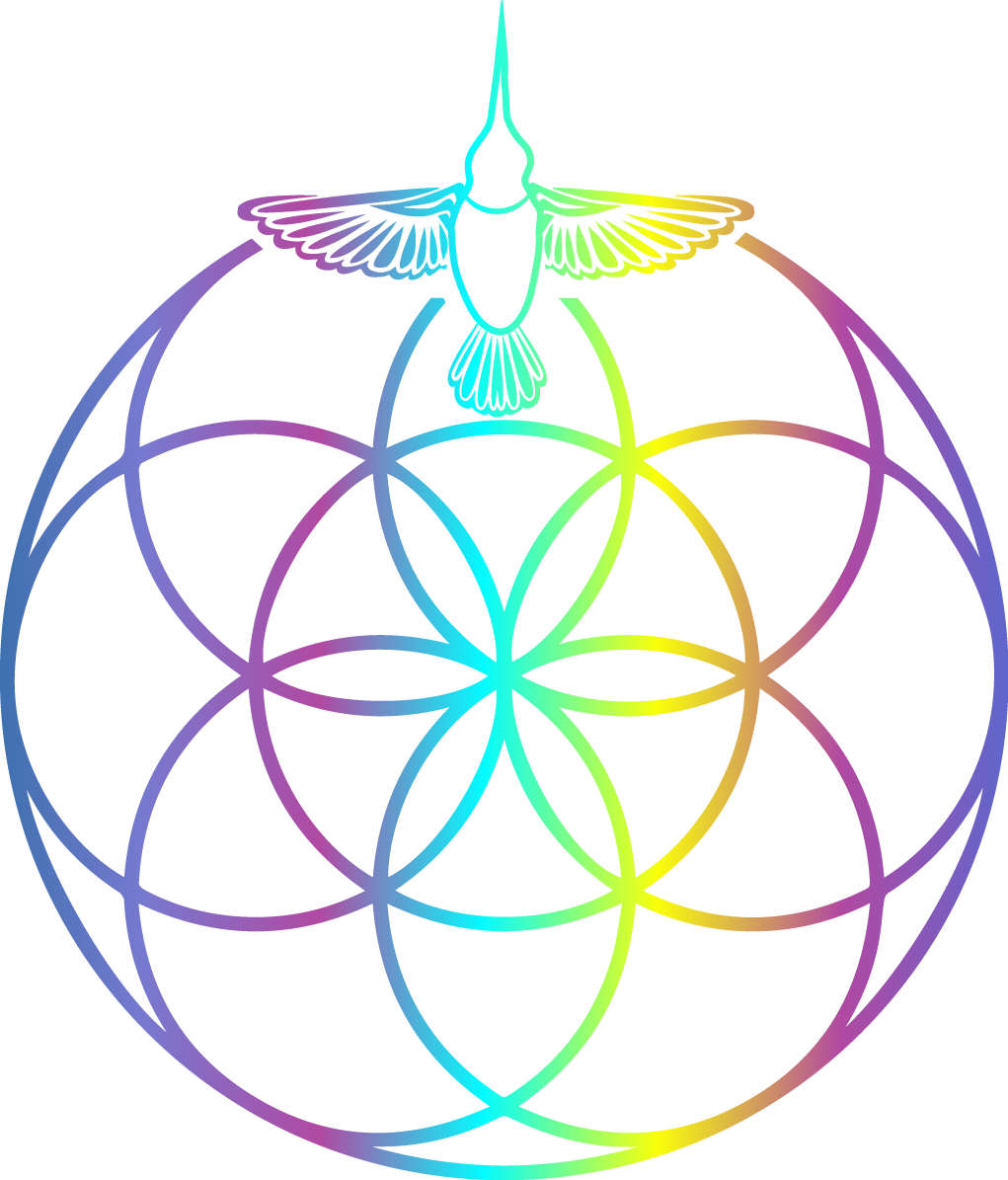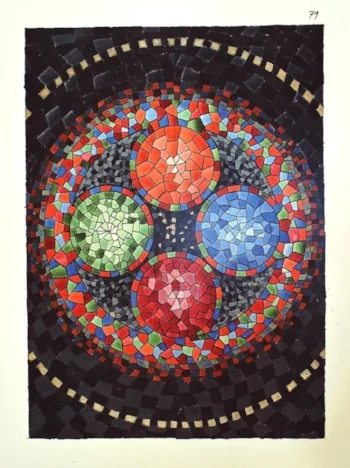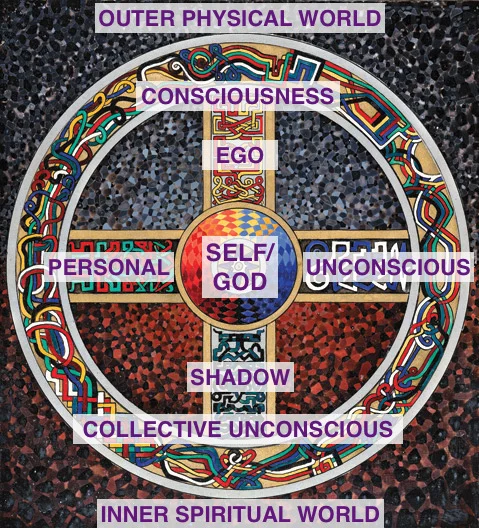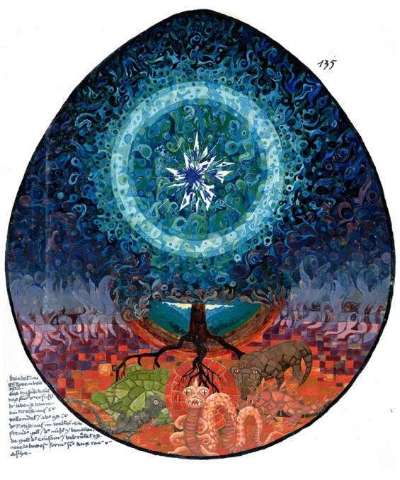In The Realms of Consciousness: Psychological Processes of Psychedelic Integration
By Sherree Malcolm Godasi, M.A.
Psychoanalyst Carl Jung denied ever using psychedelic substances or administering them to patients and fervently challenged their use as means for personal growth. Still, he personally confessed to devoting more than 40 years of his life to studying the same psychic sphere of numinous experience often recognized through the psychedelic lens. Themes that are shared in both the momentous psychedelic realm and depth psychology studies suggest the latter’s innovative grasp of the profundity of consciousness is exceptionally relevant to decoding the psychedelic experience. It is also useful for potentiating their ability to catalyze both personal growth and collective development when paralleled with active psychedelic integration. This article examines the foundations of the psychedelic integration process through core concepts of depth psychology, and how potentially solidifying fleeting psychedelic experiences through ongoing integration practice can further amplify and sustain the inevitable undertaking of human transformation.
Psychedelic Carl Jung
The Psychedelic Integration Continuum
The psychedelic journey through other states of consciousness potentially impacts the journeyer mentally, emotionally, spiritually, physically and environmentally. Following these experiences there is an immediate need to return to baseline safely and with the least possible amount of disruption to our stability, while successfully assimilating themes and lessons that are illuminated. Touring through different realms of ontological realities and gaining new knowledge encourages both psychic and concrete return to wholeness – consciously and unconsciously, personally and collectively. Harnessing psychedelic use for the purpose of psychological and spiritual (psycho-spiritual) healing and growth, the post-journey integration phase is an opportune time to rebalance with the added intention of utilizing any visions from the psychedelic plane towards self-care, personal development and a visible improvement of our lives as we evolve individually and as a people. The immediate and long-term period following the psychedelic session is when the journeyer is invited to partake in the work that supports fulfillment of these opportunities.
Psychedelic Integration: Set – Setting – Skillset - Support
Though psychedelic integration is typically regarded as a follow-up period subsequent to psychedelic journeying, ongoing engagement with psychedelic substances invites a new look at integration as a repetitive cycle that is intertwined in the journeyer’s life, and the people and communities that surround them. This perspective suggests psychedelic integration is an immersive period of mindfulness around all aspects of psycho-spiritual psychedelic use, including the preparation, engagement and post-integration stages. Recurrent use implies the journeyer is constantly engrossed within one or more of these primary stages as they potentially overlap in linear time. Within this continuum, the journeyer will ideally employ and integrate these foundations to promote an equilibrium across all stages of the psychedelic experience:
· SET - Mindset and personality of the individual, attitude towards the experience, mood at time of ingestion, and intention set towards the journey
· SETTING - Interpersonal, social and environmental surroundings
· SKILLSET - Psychedelic space navigation tools cultivating personal agency, diligence and consciousness depth/breadth exploration capability
· SUPPORT (COMMUNITY) - personal relationships serve as a witness, a testing ground, a vehicle of growth for all individuals and a live connection to the collective consciousness.
A Mandala from Jung’s The Red Book
Parallels in Depth Psychology & Psychedelic Integration
Psychedelic engagement invites one to develop a relationship with unconscious features in order to break through their perceived identity and dissolve illusory boundaries between the realms of consciousness, ultimately generating a more wholesome Self. The foundation of psychedelic journeying and integration is to become aware of unconscious material and raise it to consciousness, to acknowledge and accept it as an inseparable part of our human experience and to embody it without reservation in the everyday. This process of integration of various elements of the psyche towards congruence is a cornerstone of Carl Jung’s theory, which employs constructive psychedelic-relevant terminology.
Jungian Concepts Applied to Psychedelia
Individuation: the inner healer intelligence
· The process by which a person becomes a psychological & spiritual ‘in-dividual’: a separate, indivisible whole1, turning conscious as a singular state of Oneness.
· The inner guiding mechanism towards integration of all parts of the psyche, and the total sum of all psychic functions.
· A person learns to embrace the different parts of their human experience during this alchemical process of self-realization2.
· Entails plugging into the mind’s unconscious layers to explore various patterns relating to the personal, trans-generational and collective unconscious.
· Releasing malfunctioning attachments, assuming ownership and accepting patterns as an inseparable part of one’s personality and the world leads to a cohesion of self and psychological and spiritual growth3 - ultimately finding the god within and becoming one with the enlightened collective consciousness.
The personal and collective conscious and unconscious
· Consciousness: “the sum total of representations, ideas, emotions, perceptions, and other mental contents which the ego acknowledges”4, represents only 5% of the human mind.
· Other 95% is unconscious2, synonymous with the essence of the spirit, the soul and all creation5. Contains ideas, notions, images, views and feelings gained from personal experience that have been neglected, disremembered or repressed by the Ego.
· Abbaisement process lowers the conscious threshold to merge with the unconscious.
· Recognition of personal conscious/unconscious is crucial for optimal integration of the psyche.
· Collective unconscious “contains the whole spiritual heritage of mankind’s evolution”7, accommodates accumulated psychological content, behavioral imprints and life patterns passed down intergenerationally and shared with all other beings8.
· The root of the personal unconscious thus influences it profoundly, manifests through dreams, imagination and other states of consciousness visited through various meditative methods.
The Ego
· The task force aiming to regulate psychological stabilization between external demands of reality and internal conflicts of the individual9.
· Fully recognizes itself as an independent & separate “I” identity2, but its limited perception only represents the conscious 5%.
· Forced to surrender to unconscious/unfamiliar concepts it fears its own death. Positive disintegration10 is a necessary step in individuation and psychological growth: “our ideal image of ourselves must die as we recognize and integrate the shadow side of our nature and become whole”2.
The personal and collective Shadow
· All negative and some positive aspects of the personality the Ego consciously or unconsciously denies in favor of preserving its known identity2.
· Collective Shadow: our primal and gross ancestral nature, communal spiritual underworld which connects all beings with archetypal imprints of generations past.
· Shadow left unrecognized, the individuation process and psychological development might be stagnant at best or deteriorate to a state of psychosis at worst, deepening the collective Shadow. Similarly with personal Shadow illumination the individuation process is accelerated and the collective Shadow is minimized.
Archetypes
· Hypothetical symbols of repeated psychological content inherited from the ancestral past and shared by all humans through the collective unconscious.
· Impressions on individual/collective psyche manifested throughout time in universal themes like motherhood, birth and death, religious and transpersonal states.
· Experienced differently by individuals through interactions with their personal unconscious.
· If the Ego identity feels overwhelmed from the exposition of archetypes suppression and denial may occur2.
· Proper integration of archetypes through the individuation process is considered imperative to psychological health, growth and self-actualization.
The Self
· A central, spiritual archetype of wholeness originating in the collective unconscious and transcending beyond the individual’s Ego-based personality2.
· Following acknowledgement of the Ego, Shadow and archetypes, encountering the true Self with the intention of its actualization and embodiment through conscious daily living and within the collective framework is the goal of the Jungian individuation process and the epitome of psychedelic integration.
Jungian Mandala and the organization of consciousness
Individual & Collective Integration
Jung’s view of the individual as a vehicle of consciousness that ascends in human evolution points to a recognition of personal responsibility and commitment to inner growth benefiting the individual and the collective. A subjective individuation process that is amplified through psychedelic use aids in integration of the psyche and can lead to transformation in all aspects of human life. Similar to the Tibetan Buddhist model of transpersonal stages11 the individual mindfully works to:
1. Process to comprehend the insights and their manifestation through the Ego, Shadow and archetypal imprints;
2. Creating a mindful container to experience them in the everyday and taking action to release undesired patterns;
3. Stabilize and solidify desired behaviors with ongoing practice;
4. Reach liberation as a self-actualized, conscious Self.
The personal integration journey (short or long term) concurrently ignites a similar process in the collective counterpart:
· The transpersonal state12 encountered in the psychedelic realm fulfills the journeyer with a divine perspective on life, alerts to the true nature of Self and introduces a new capacity for personal & collective awareness.
· With an expanded mindset and worldview the they are compelled to revisit their familiar reality through a different lens.
· An inner examination of disturbances of the Ego-based reality, Shadow & archetypes are necessary gestures towards psyche integration.
· Through mindful, ongoing integration the visions, lessons, knowledge and understandings gained in the psychedelic plane are interpreted, manifested and imprinted in the individual’s ordinary, daily state of consciousness.
· The interior relationship with the psyche, investigated and augmented in personal integration, is reenacted, mirrored and validated in exterior relationships within the community, contributing to the psychological well- being of the individual and the fellowship/health of the social group.
· A fulfilled and purposeful individual willingly contributes to the greater collective experience, perpetuating a universal pattern of expansion and transformation, influencing mankind/evolution indefinitely.
· The personal abbaisement process enlightens the collective consciousness, resulting in a more harmonious existence for all beings.
A Tree of consciousness from The Red Book
Psychedelic Resolution-Revolution-Evolution
In summary, along with an ability to offer near-immediate resolution of intrapersonal disputes through inner inquiry, psychedelics can be regarded as educational tools revealing to the journeyer extra-ordinary knowledge, concepts, notions, ideas and possibilities otherwise left unknown. They can attune the individual to a multitude of intricate personality traits sometimes disregarded or ignored by conventional therapy. These include a hyper-awareness to reality, an understanding of the human condition, the ability to surrender to the natural flow of life, feelings of freedom and liberation, and most importantly, a detachment from ego-identity in favor of identifying with the higher, true Self, of which fulfillment of one’s potential and actualization are bi-products.
Through intentional psychedelic journeying and integration work, personal awareness and development can be intensified and expedited, leading to a rapid and positive transformation in the collective. Within the context of collective expansion, recognizing the psychedelic ability to inactivate any systematic genetic and cultural programs and filters in the brain prizes them as no less than evolutionary instruments13,14 Users of these instruments can greatly benefit from an organized communal integration support system which not only recognizes the potential of the psychedelic experience, but can further magnify its role as a catalyst for personal and collective growth and development.
References
1. Jung, C. G. (1975). Letter to A. M. Hubbard, February 15, 1955 (R. Hull, Trans.). In G. Adler & A. Jaffe (Eds.), C.G. Jung Letters (Vol. 2, 1951-1961), pp. 222-224). Princeton: Princeton University Press.
2. Hill, S. J. (2013). Confrontation with the unconscious: Jungian depth psychology and psychedelic experience. London: Muswell Hill Press.
3. Dunne, C. (2012). Carl Jung: Wounded Healer of the Soul, An Illustrated Biography. New York: Watkins Publishing.
4. Jung, C. G. (1940). The meaning of individuation (S. Dell, Trans.). In The integration of the personality. London: Routledge & Kegan Paul.
5. Johnson, R. A. (1986). Inner work: Using dreams and active imagination for personal growth. San Francisco: Harper & Row.
6. Whitney, M. (Director). (1986). Matter of heart. [Motion picture]. (2004). Kino on Video.
7. Jung, C. G. (1969c). The structure of the psyche. In The Collected Works of C.G. Jung (Vol 8). (Original work published 1931).
8. Jung, C. G. (1969b). Basic postulates of analytical psychology. In The Collected Works of C.G. Jung (Vol 8). (Original work published 1934).
9. Berzoff, J., Flanagan, L. M., & Hertz, P. (2011). Inside out and outside in: Psychodynamic clinical theory and psychopathology in contemporary multicultural contexts (3rd ed.). Lanham: Rowman & Littlefield Publishers, Inc.
10. Naranjo, C. (1973). The Healing Journey: Pioneering approaches to psychedelic therapy. New York: Random House. ISBN 978-0394488264.
11. Walsh, R. (2012). From state to trait: The challenge of transforming transient insights into enduring change. In Spiritual growth with entheogens: Psychoactive sacramental and human transformation. South Paris, ME: Park Street Press.
12. Grof, S. (2008). A brief history of transpersonal psychology. International Journal of Transpersonal Studies, 27, 46–54.
13. Metzner, R. (1968). On the evolutionary significance of psychedelics. Main Currents in Modern Thought. 25(1), 20-25.
14. Metzner, R. (2002). The Role of Psychoactive Plant Medicines. In C. S. Grob, (ed.) Hallucinogens: A Reader. Tarcher. ISBN: 978-1585421664.




